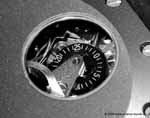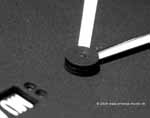Mission Impossible Hunted:
The Official Watch of the Musée International d'Horlogerie, La Chaux-de-Fonds
September 2005
Part
1
Click on small image to view large ones!
1.
Introduction:
Ludwig Oechslin, custodian of the world-known Musée
International d'Horlogerie (MIH), La Chaux-de-Fonds, is an universal
scholar in the truest (and rarest) sense: Dr. Oechslin studied Archaeology,
History of Art, Philosophy, History, Greek and Latin at the University
of Basel, Switzerland, and made his PhD in Philosophy and History of
Natural Sciences in 1983. As a truely polymath person, he acquired the
certificate as master watchmaker beneath his studies for the postdoctoral
lecture qualification in Archaeology of Industrial Technology in 1993.
Ever since then, he caused a sensation whenever a watch or a complication
developed by him was presented to the eagerly waiting public: His friendship
with Rolf Schnyder, owner and CEO of the watch manufacturer Ulysse Nardin,
made this very watch company one of the most innovative in the industry:
The "Trilogy" astronomic collection, the Perpetual Ludwig
and last but not least the groundbreaking "Freak" are widely-known
testimonials of Dr. Oechslin's impressive portfolio. Despite being complicated,
one common characteristic is typical for his creation: they are all
easy to use!
Leap in time 1: since 2001 custodian of the MIH, Dr. Oechslin contributed massively to the development of the MIH, but also the theory of watch collecting and restauration (you may want to read my report on a speech about the "ethics and philosophy of watch restauration"), but he also is bound to be commercially neutral, that means that he is no longer allowed to work for commercial companies such as his long-time employer Ulysse Nardin. However, this manufacturer is well equipped with Dr. Oechslin's ideas and constructions for years to come...
Leap in time 2: 2003, it's prickling in Dr. Oechslin's brain to see a simple watch he constructed to go into production... But there is the commercail neutrality obligation... but, wait, isn't there this monumental clock the MIH acquired in 2001, but which's restauration is postponed due to lack of funds??? How about to fund it with a MIH watch... YES!!!
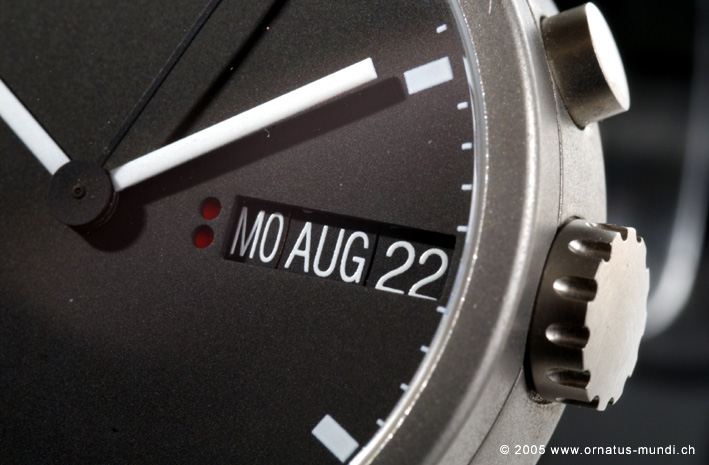
Now we are already in the middle of the whole story. The MIH needed cash for the restauration of the monumental clock (more in part 3 of this report), Ludwig Oechslin could create yet another watch and the MIH visitors could acquire a perfectly suitable souvenir. Every part of this game seemd to be satisfied, but there were still two variables open: First, there is an initial funding needed, and second, the watch has to be brought into serial production (prototyping, testing, modifications...) and finally produced somewhere - entirely in Switzerland, for sure!
For the first problem, Dr. Oechslin went to the high-end watch retailer Embassy in Lucerne, a strong supporter for independent watchmakers. During his famous 5 ultra-short Espressi, they talked about the project of a museum watch worth the reputations of both, the MIH and Embassy, and agreed to cooperate for this project. Everything seemed fine, but there was a big surprise ahead, as Beat Weinmann, person in charge for this project at Embassy, explains: "At Embassy, we are Ulysse Nardin authorised agents and therefore familiar with Oechslin's complicated creations, and consequently expected something ultracomplicated as the MIH watch. We were completely wrong...". What a - aehem! - surprise when Dr. Oechslin proudly presented this prototype as the MIH watch:
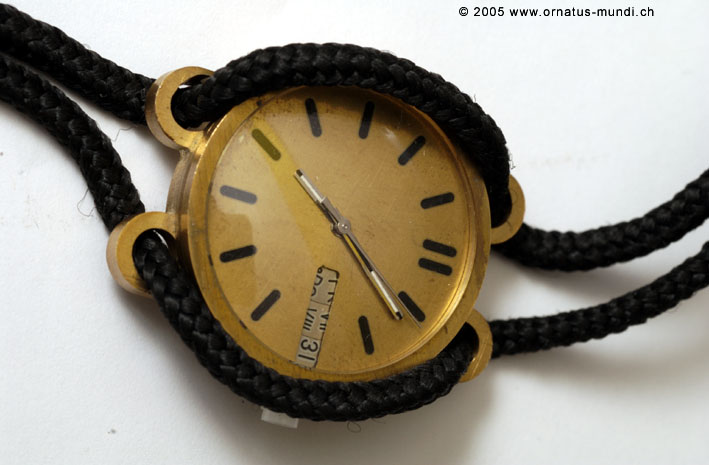
What is
that? A simple automatic watch, based on the mundane ETA 2892-2, with
a complete calender? Well, it's not that easy, and yes, it is: Ludwig
Oechslin constructed an annual calender, that is a calender which automatically
displays the correct month lengths, except for February each year, when
it has to be corrected manually. A very usefull, no-nonsense complication.
Typically Oechslin, the calender can be adjusted via that crown, and
not only in forward, but also backwards, because Oechslin avoided the
use of springs, but instead employed wheels (more on this later in part
2). Furthermore, the watch displayed the date easily readable in one
window, and not scattered over the dial like many complete, annual or
perpetual calenders on the market. And, and this is the true challenge:
the mechanism consisted of only 9 (nine!) moving parts!
After a deep breath by the remaining participants in this project, it
soon became clear: Oechslin proposed something unique, simple, useful
and very intellectual. It immediately triggered fascinated discussions
on how to proceed, with the next question being whom to entrust with
the further developing, prototyping and finally production. Ludwig Oechslin
had only one answer: Paul Gerber in Zurich is the man
for these tasks!
Paul Gerber, well-known for his own collection of watches (see my article on his innovative Calibre 33 watch), for the world's most complicated wristwatch (the famous Piguet/Muller/Gerber Ultracomplication), but also for countless construction work for the big names in luxury watchmaking, was fascinated by the idea from the very beginning and happily accepted the challenge. First, he decided that the calender mechanism needed a reliable base movement that was able to provide the necessary torque to move the calender plates (on months with only 30 days, three discs have to be moved simultanously, see part 2). The movement of choice proved to be the ETA/Valjoux caliber 7750, well known as reliable workhorse caliber. Since the watch should have a central permanent seconds hand, Paul Gerber decided to remove the subseconds and instead to use the chonograph seconds counter. To make it clear from the outside that this watch is no longer intended to be used as a 'normal' chronograph. Paul Gerber modified it from a two-pusher to a mono-pusher chronograph, additionally, the minuted counter was omissed as well. His first prototype looked even more mundane than Oechslin's ETA 2892-2 based watch:
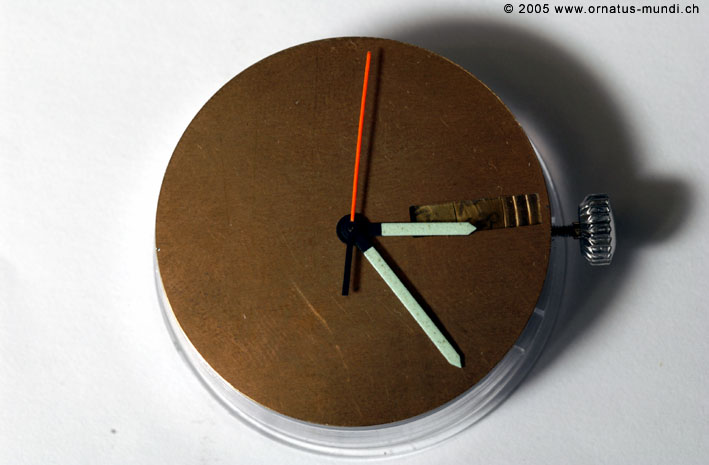
Now, you might expect that the technical site was set. But not so for Ludwig Oechslin! "What", he said, shaking his head, "what is this supposed to be? This is not a chronograph, this is nearly useless with only a 60 seconds counter!". Paul Gerber smiled, went home in his atelier and shortly after he presented the solution... more further down the article!
Now, the
scene was set for the next step, the design process. After a thorough
evaluation, an industrial designer who never designed a watch before
was asked to submit a design proposal: Christian Gafner,
who previously earned his merits for example with the design of the
official Swiss Army's sunglasses. These are modularly designed to facilitate
changes of nose-pads, earpieces or protection filters, so that they
are equally suitable for alpinists or pilots.
Gafner therefore was not burdened with common watch designes and startet
from scratch. He proposed an easily readable watch with absolutely no
inscription on the front, but only a small "MIH" at the 9
o'clock position: A subtle hint pointing to ingenious calender mechanism
using only 9 parts. It is intriguing that the MIH is exactly opposite
of the date at 3 o'clock.
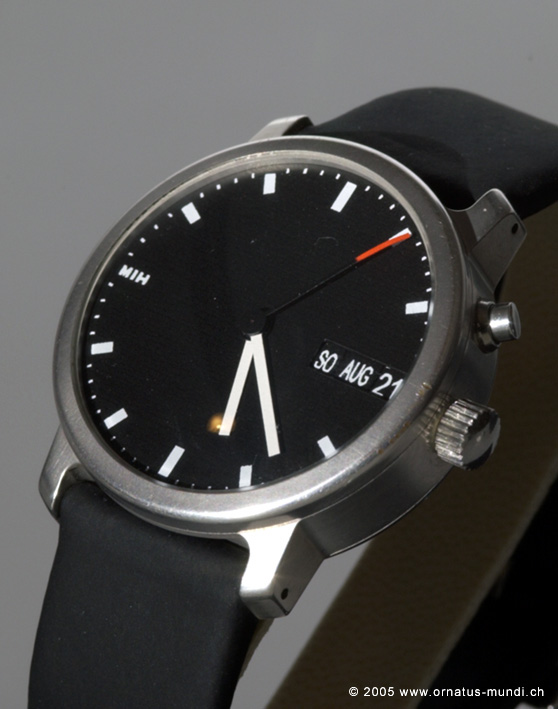
With this little "MIH" at 9 o'clock the game of internal relations, hints and symbolisms began. In the end, the watch is more a philosophy than a watch, the whole design tells stories about the thoughts that went into it's creation. After several interations, the final watch, housed in a case made of light Titanium, looked like this:
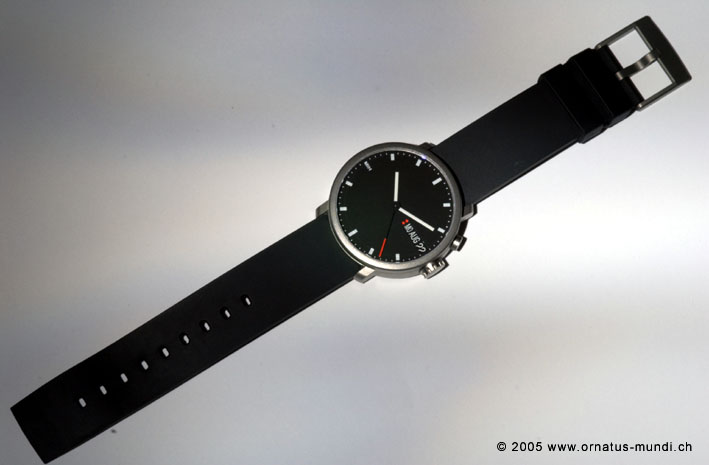

2.
Design:
The watch is made of lightweight Titanium, a very skin-friendly and
anti-allergic material. As an additional feature Titanium pretty well
transports the typical "wobble" of the Valjoux 7750 base movement
to the wearer's wrist, reminding on the mechanical micro-cosmos inside
the watch.
All optical elements are arranged in explainable, transparent relation
to each other, and everything is centered around the axis of the hands,
the central point of this watch: The curvature of the crown, the pusher,
the outer edges of the lugs, and the curvature of the buckle. Even the
width of the lugs corresponds to the width of the bezel (large image
above; small images below, left and middle left). The dial has 12 indices
(if one counts the "MIH" and 9 and the date window at 3 o'clock),
representing the 12 hours of each half-day (large image below, top),
also the crown, which features 12 kerfs (small images below, middle
right and right), and the case-back, which is secured to the case by
12 screws (large image below, bottom). The "MIH" has the exactly
same dimension as the indices at 12 and 6 o'clock, demonstrating the
equalty of each of the 12 hours. As already mentioned, the "MIH"
is at 9 o'clock to hint to the 9 parts comprising the calender mechanism.
Also, the strap, made of rubber, features 9 holes (which are angled
to perfectly accept the pin) to indicate the same (small images below,
left and middle).
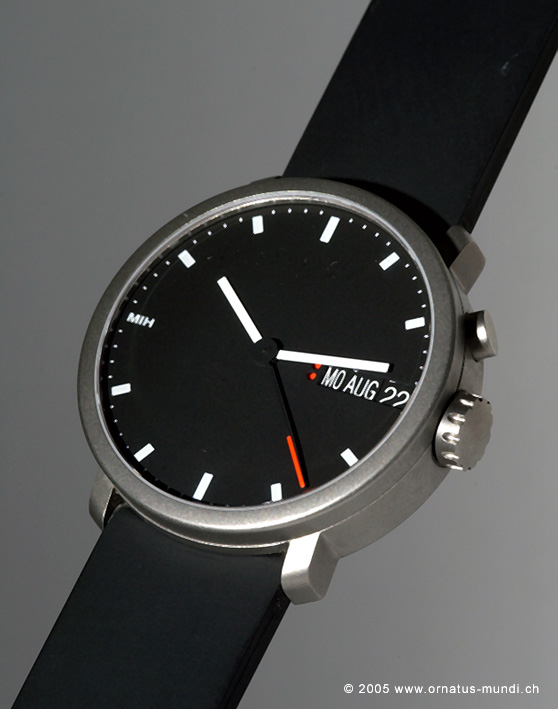
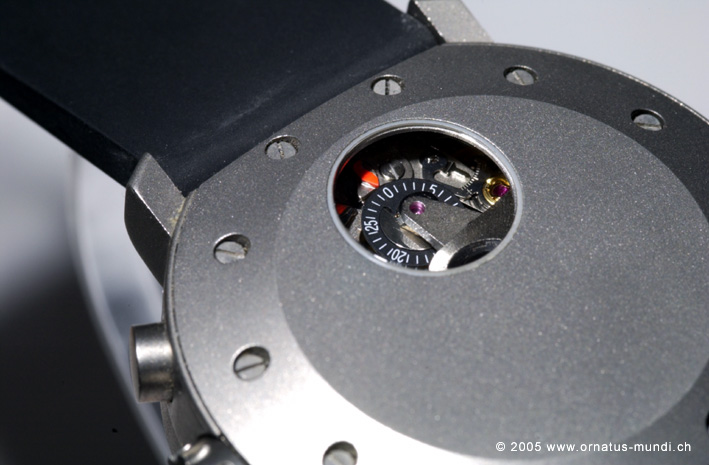
The back also reveals Paul Gerber's genial solution for the chronograph problem: he constructed a 30min disc to be fixed on the 30min-counter wheel - simple but effective, and additionally giving a very interesting insight in the movement (large image above; small images below, left).
As a further,
very subtle manifestation of the watch's artistic finesse are the hands.
Entirely coated with Super-Luminova, they also communicate with each other
and the other elements of the dial: The hour hand is shorter than the
minute hand by exactly the length of a 12 o'clock, 6 o'clock or "MIH"
index. The minute hand touches these indexes exactly, and the seconds
hand touches the 1-minute indices. The red tip of this hand is exactly
the distance between the hour hand and the minute indices - that is, as
already mentioned, the length of the "MIH" index (small images
below, middle). All hands have a diameter of 3mm at the center pinnions,
again directing numerically to the date display at 3 o'clock (small images
below, right).
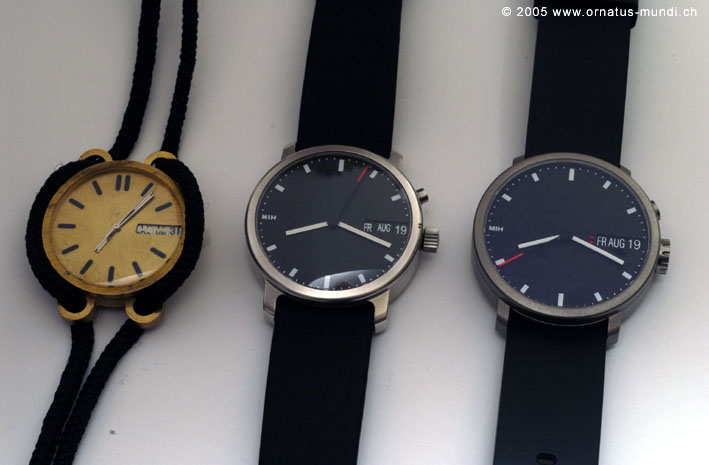
So far, a truely mesmerising development, if one follows the long way from the first prototype to the final product (large image above). True masters gave their distinctive input, masterfully wrapped by an artist into a very appropriate, quite intellectual packaging (see part 3!). No marketing, no distribution (only available at the MIH and at Embassy!). Not even the calender or the chronograph mechanisms are patented - everyone is free to use them, but should mention the authors. A watch to grow with, surely. A watch that is much more than is seems on the first view.






